NCERT Solutions for Chapter 10 Tenths And Hundredths
NCERT Solutions for Class 5 Maths Chapter 10 Tenths And Hundredths of the NCERT textbook is solved with errorless solutions by experts on Home-tuition.com. Chapter 10 Tenths And Hundredths is fully solved in the below pdf. You can download a chapter-wise free pdf of Chapter 10 Tenths And Hundredths.
What are you going to learn in Chapter 10 Tenths And Hundredths?
Tenths and Hundredths-Let's talk about a few issues. How long was the shortest pencil you've ever used? What is the length of this pencil? Use a scale to weigh it. How accurate is your prediction? We can see that Anil used a lens to magnify the image so that he could accurately estimate the length. Some refer to it as 3 centimetres, while others refer to it as 6 centimetres. Some refer to it as 3milimetres, while others refer to it as a seven-tenth of a centimetre. One-tenth of a centimetre is also known as 0.1 centimetres. It's written as "zero one centimetre." We will measure several objects and learn about tenths and hundredths in this manner.
Let's talk about a few issues. How long was the shortest pencil you've ever used? What is the length of this pencil? Use a scale to weigh it. How accurate is your prediction? We can see that Anil used a lens to magnify the image so that he could accurately estimate the length. Some refer to it as 3 centimetres, while others refer to it as 6 centimetres. Some refer to it as 3milimetres, while others refer to it as a seven-tenth of a centimetre. One-tenth of a centimetre is also known as 0.1 centimetres. It's written as "zero one centimetre." We will measure several objects and learn about tenths and hundredths in this manner.
Find below a free pdf of NCERT Solutions for Class 5 Maths Chapter 10 Tenths And Hundredths
Page No 134:
Question 1: What was the length of the smallest pencil you have used? How long is this pencil? Guess ___________cm Measure it using a scale. How good is your guess? We can see that Anju used a lens to make it look bigger.
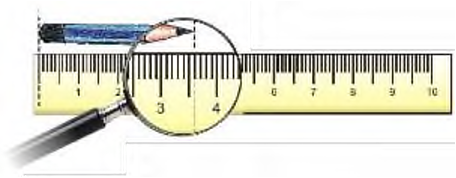
Answer:
The smallest pencil that I had used was about 1 cm long. I think the given pencil is more than 3 cm.
With the help of scale, the length of the pencil comes out to be 3.6 cm. So, my guess was correct.
Disclaimer: The length of the smallest pencil that you have used varies from student to student. The answers provided here are for reference only.
Page No 135:
Question 1: What does 0.9 cm mean? It is the same as _____________millimetres. We can also say this is nine-tenths of a cm. Right? So 30.5 cm is the same as _________cm and __________ millimeter. About how many of the big frogs will fit on the 1 m scale?__________If they sit in a straight line about how many of the small frogs will cover 1 m?___________
Answer:
We know that, 1 cm = 10 mm So, 0.9 cm = 9 mm 0.9 cm means 9 mm It is the same as 9 millimetres.
So 30.5 cm is the same as 30 cm and 5 millimeter. Now, 30.5 cm = 30 cm and 5 mm
We know that, 1 m = 100 cm
Length of the biggest frog = 30.5 cm Thus, a maximum of 3 big frogs can fit on 1m scale.
Length of each small frog = 0.9 cm Thus, a maximum of 111 small frogs can sit in a straight line and cover 1 m.
Question 2:
(1) Length of the nail ______2 cm and ________mm or 2._______cm.
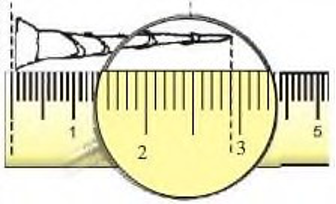
(2)

The length of this lady finger (bhindi) is _________cm and _______mm. We
(3) Using the scale on this page find the difference in length between candle 1 and candle 3.
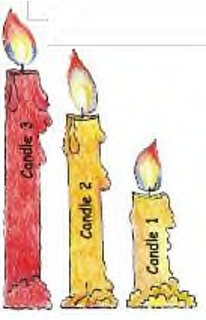
|
Length of |
Length in cm and mm |
Length in cm |
|
Candle 1 |
||
|
Flame 1 |
||
|
Candle 2 |
||
|
Flame 2 |
||
|
Candle 3 |
||
|
Flame 3 |
Answer:
(1) Length of nail = 2 cm 9 mm Now, 10 mm = 1 cm 1 mm = 110cm
9 mm = 0.9 cm
So, 2 cm 9 mm = 2.9 cm
(2) Length of lady finger is 8 cm and 4 mm Now, 10 mm = 1 cm 1 mm = 110cm
4 mm = 0.4 cm
So, 8 cm 4 mm = 8.4 cm
(3)
|
Length of |
Length in cm and mm |
Length in cm |
|
Candle 1 |
2 cm 9 mm |
2.9 cm |
|
Flame 1 |
1 cm 3 mm |
1.3 cm |
|
Candle 2 |
4 cm 9 mm |
4.9 cm |
|
Flame 2 |
1 cm 9 mm |
1.9 cm |
|
Candle 3 |
6 cm |
6.0 cm |
|
Flame 3 |
1 cm 9 mm |
1.9 cm |
Page No 137:
Question 1: Guess the lengths to draw these things. Ask your friend to draw the same. After you make the drawing use a scale to measure the length. Whose drawing showed a better guess?
|
Guess its length and draw |
Measure of your drawing |
Measure of your friend’s drawing |
|
An ant of length less than 1 cm |
||
|
Pencil of length about 7 cm |
||
|
A glass 11 cm high with water up to 5 cm |
||
|
A bangle of perimeter 20 cm |
||
|
A curly hair of length 16 cm |
Answer:
Disclaimer: Students are advised to prepare the answer on their own.
Question 2: Which line is longer? A or B? Measure each line and write how long it is in centimetres. How good is your guess?
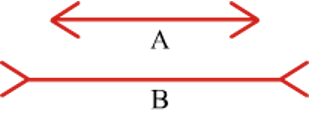
Which line is longer? C or D? Measure each line. How good is your guess?

Answer:
I think line B is longer than line A. With the help of ruler, we get the measurement of line A as 4.6 cm and line B as 4.6 cm. That means, both the lines are of same length. So, our guess was incorrect.
I think both the lines C and D are of same measurement. With the help of ruler, we get the measurement as 3.2 cm for both the lines. So, our guess was correct.
Disclaimer: The guess may vary from student to student. The answers provided here are for reference only.
Page No 138:
Question 1: What is the length of a 100 rupee note? Guess. Now measure it using a scale.
Now guess the length and width of many other things. Measure and find the difference between your measure and your guess.
|
Size of |
Your guess in cm |
Your measure in cm |
||
|
length |
width |
length |
width |
|
|
100 Rupee note 10 Rupee note 20 Rupee note |
||||
|
5 Rupee note Post card Math-Magic book |
Answer:
My guess: Length of notebook = 25 cm Breadth of notebook = 20 cm Measure: Length of notebook = 22.3 cm Breadth of notebook = 18.3 cm Difference in length between my guess and measure = 25 − 22.3 = 2.7 cm
Difference in breadth between my guess and measure = 20 − 18.3 = 1.7 cm
|
Size of |
Your guess in cm |
Your measure in cm |
||
|
length |
width |
length |
width |
|
|
100 Rupee note |
20 |
10 |
15.8 |
7.3 |
|
10 Rupee note |
15 |
7 |
13.7 |
6.3 |
|
20 Rupee note |
12 |
6 |
14.7 |
6.3 |
|
5 Rupee note |
10 |
5 |
11.7 |
6.4 |
|
Post card Math-Magic book |
12 25 |
7 20 |
10.5 24 |
6.5 18 |
Page No 139:
Question 1:
(1) How many paise does a matchbox cost? _________
(2) How many matchboxes can be got for Rs 2.50? _________
(3) How many rupees does the soap cost? _________
(4) Arun wanted to buy a soap. He has a five-rupee coin, 2 one-rupee coins and 4 half-rupee coins. Write in rupees what money he will get back.
a) An egg costs two and a half rupees. How much will one and a half dozen cost? (b) How many pens can Kannan buy? How much money is
(6) The price of two pens is Rs___________. Can she buy two pens?

Answer:
We know that, Re 1 = 100 paise
(1) Cost of a matchbox = Re 0.50 = 50 paise
(2) Cost of a matchbox = Rs 50 paise Amount of money to buy matchboxes = Rs 2.50 = 2 rupees 50 paise = 2 × 100 paise + 50 paise = 200 paise + 50 paise = 250 paise
So, number of matchboxes bought for Rs 2.50 = 250 ÷ 50 = 5 Thus, 5 matchboxes can be bought for Rs 2.50.
(3) Cost of a soap = Rs 8.75
(4) We know that, Rs 1 = 100 paise Arun has a five-rupee coin, 2 one- rupee coins and 4 half-rupee coins. Now, Rs 5 = 5 × 100 paise = 500 paise
2 one rupee coins = 2 × 100 paise = 200 paise 4 half-rupee coins = 4 × 50 paise = 200 paise Total money with Arun = 500 paise + 200 paise + 200 paise = 900 paise
Cost of a soap = Rs 8.75 = 8 rupees 75 paise = 8 × 100 paise + 75 paise = 800 paise + 75 paise = 875 paise
Money left with Arun after buying a soap = 900 paise − 875 paise = 25 paise = Rs 0.25
-875025 Thus, after buying a soap, Arun will get back Rs 0.25.
(a) Cost of an egg = Rs 2.50 = 2 rupees 50 paise = 2 × 100 paise + 50 paise = 200 paise + 50 paise = 250 paise
Now, one dozen eggs = 12 eggs So, one and a half dozen eggs = 12 + 6 = 18 eggs
Cost of 18 eggs = 18 × 250 paise = 4500 paise = Rs 45
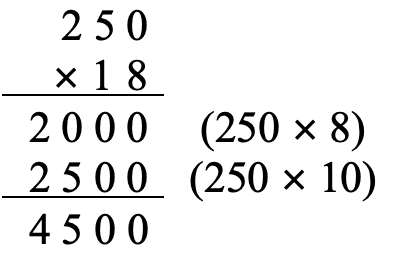
Thus, cost of one and half a dozen eggs is Rs 45.
(b) Total money with Kannan = Rs 60 Cost of one and a half dozen eggs
= Rs 45 Total money left with Kannan after buying eggs = Rs 60 − 45 = Rs 15 = 1500 paise
Now, Kannan uses the money that is left for purchasing pens. Cost of a pen = Rs 6.50 = 6 rupees 50 paise = 6 × 100 paise + 50 paise = 600 paise
+ 50 paise = 650 paise
Cost of 2 pens = 2 × 650 paise = 1300 paise = Rs 13
So, Kannan can buy only two pens with the amount of money that was left with him after purchasing eggs. Now, money left with Kannan after purchasing pens = 1500 paise − 1300 paise = 200 paise = Rs 2 Thus, Kannan was left with Rs 2 after buying 2 pens.
Question 1: Match each yellow box with one green and one pink box.
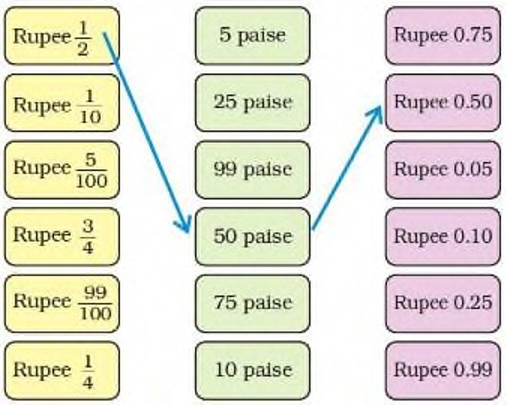
Answer:
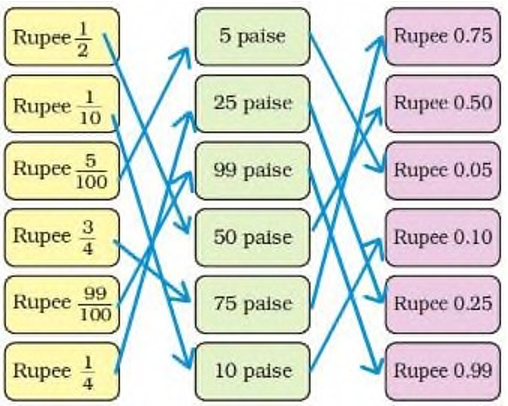
Question 2: Colourful Design What part of this sheet is coloured blue?__________/10 What part of the sheet is green?_______Which colour covers 0.2 of the sheet?
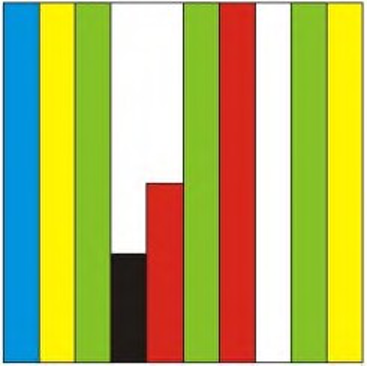
Answer:
Total number of strips in the sheet = 10 Number of blue coloured strips = 1
So, part of the sheet that is blue = 1/10
Thus, 1/10of the sheet is blue.
Number of green coloured strips = 3
So, part of the sheet that is green = 3/10
Thus, 3/10of the sheet is green.
Number of yellow coloured strips = 2
So, part of the sheet that is yellow = 2/10 = 0.2
Thus, 2/10of the sheet is yellow.
Question 3: Look at the second sheet. Each strip is divided into 10 equal boxes. How many boxes are there in all?
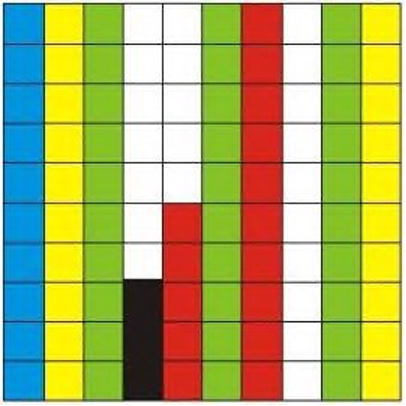
Is each box 1/100 part of the sheet? How many blue boxes are there?________Is blue equal to 10/100 of the sheet? We saw that blue is also equal to 1/10 of the sheet. We wrote it as 0.1 of the sheet.
Can we say 10/100 = 1/10 = 0.10 = 0.1?
Think: Can we write ten paise as 0.1 of a rupee? How many boxes are red? What part of the sheet is this? 15/ Can we also write it as 0.15 of the sheet? Now 3/100 of the sheet is black. We can say 0._______sheet is black. How many white boxes are there in the sheet? What part of the second sheet is white?________
Answer:
Number of boxes in 1 strip = 10 There are a total of 10 strips in the sheet.
So, number of boxes in 10 strips = 10 × 10 = 100 Yes, each box is part of the sheet.
There are 10 blue boxes in the sheet. Yes, blue equals to of the sheet. It is given that blue is equal to of the sheet. Now,

Thus, 1/10 is also equal to of the sheet. And,
= 0.1
= 1/10 = 0.10 = 0.1
Now, 100 paise = Re 1 So, we need ten 10 paise coins to make Re 1. Thus, we can say that 10 paise is
of a rupee. Now,
= 0.1 So, 10 paise is 0.1 of a rupee.
There are a total of 15 red boxes in the sheet.
Total number of boxes in the sheet = 100 Part of the sheet that is red = 15/100
Now,
= 0.15 So, 0.15 of the sheet is red.
It is given that 3/100 of the sheet is black. Now,
= 0.03 So, we can say that 0.03 of the sheet is black.
There are a total of 22 white boxes in the sheet. So, part of the sheet that is white =
= 0.22 Thus, 0.22 of the sheet is white.
Page No 141:
Question 1: The school at Malappuram has its sports day. The first five children in the Long Jump are:
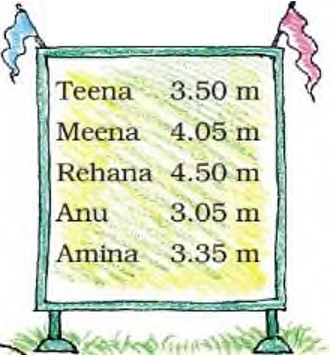
Who is the winner in the long jump? ________ Write the names of the I, II and III winners on this stand.

Answer:
It is given that 4.50 m is longest jump.
Thus, Rehana is the winner in the long jump.
The 1st winner is Rehana, 2nd winner is Meena, and 3rd winner is Teena. We know that, 100 cm = 1 m so, 1 cm =
1/100 m 1 cm = 0.01 m
So, we can also write 1 cm as 0.01 m.
Page No 142: Question 1: Write in Metres
|
3 metre 45 centimetre |
|
99 centimetre |
|
1 metre and 5 centimetre |
Answer:
We know that, 100 cm = 1 m 1 cm =
1/100m = 0.01 m Now, 3 m 45 cm = 3 + 45/100m = 3 + 0.45 m = 3.45 m
99 cm = 99/100
m = 0.99 m
1 m 5 cm = 1 + 5/100
m = 1 + 0.05 m = 1.05 m
|
3 metre 45 centimetre |
3.45 |
metres |
|
99 centimetre |
0.99 |
metres |
|
1 metre and 5 centimetre |
1.05 |
metres |
Question 2:
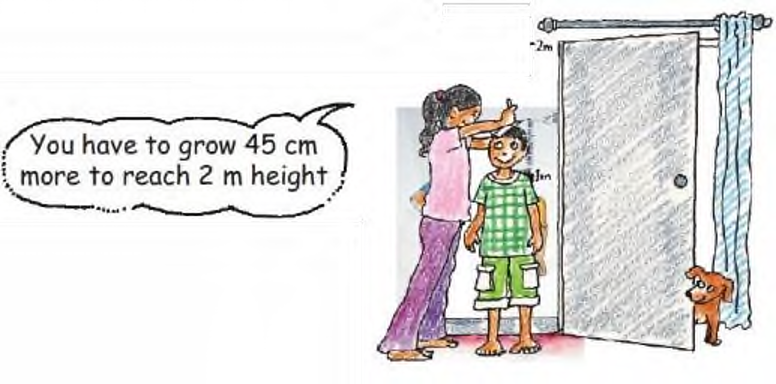
What is Dinesh’s height in metres? _______m ______cm.
Answer:
Dinesh has to grow 45 cm more to reach the height of 2 m. Now, 1 m = 100 cm So, 2 m = 200 cm
Height of Dinesh = 200 − 45 = 155 cm
200 − 45 = 155 Now, 155 cm = 100 + 55 cm = 1 m 55 cm
Thus, Dinesh’s height is 1 m 55 cm.
Page No 143:
Question 1: Shivam Bank has a chart to show us how many Indian rupees we can get when we change the money of different countries.
|
Country |
Money |
Changed into Indian Rupees |
|
Korea Sri Lanka Nepal |
Won Rupee (SL) Rupee |
0.04 0.37 0.63 |
|
Hong Kong South Africa China U.A.E. U.S.A. Germany England |
Dollar (HK) Rand Yuan Dirham Dollar Euro Pound |
5.10 5.18 5.50 10.80 39.70 58.30 77.76 |
(This is the rate on 15-2-2008)
(A) The money of which country will cost the most in Indian Rupees?
(B) Mithun’s uncle in America had sent him 10 USA dollars as a gift. Mithun used 350 rupees for a school trip. How much money was left with him?
(C) Majeed’s father is working in Saudi Arabia. He gets 1000 Saudi Riyal as salary. Arun’s father who is working in Sri Lanka gets 2000 Sri Lankan Rupees. Who gets more Indian rupees as salary?
(D) Leena’s aunty brought a present for her from China. It cost 30 Yuan. Find what it costs in Indian rupees.
(E) Astha wants some Hong Kong Dollars and Won.
(1) How many Won can she change for Rs 4? For Rs 400?
(2) How many Hong Kong Dollars can she change for Rs 508?
Answer:
(A) The money of England will cost the most in Indian Rupees as 1 pound is equal to Rs 77.76
(B) We find from the chart that, 1 US dollars = Rs 39.70 = 39 rupees 70 paise = 39 × 100 paise + 70 paise = 3900 paise + 70 paise = 3970 paise 10 US dollars = 10 × 3970 paise = 39700 paise = Rs 397.00
So, Mithun got Rs 397.00 from his uncle as a gift.
Money spent on school trip by Mithun = Rs 350.00 So, money left with Mithun = Rs 397.00 − 350.00 = Rs 47.00
397.00 − 350.00 = 47.00
(C) Here, we are considering the exchange rates of Dirham in place of Saudi Riyal. Salary of Majeed’s father = 1000 Dirham
We find from the chart that, 1 Dirham = Rs10.80 = 10 rupees 80 paise = 10 × 100 + 80 paise = 1000 + 80 paise = 1080 paise
So, 1000 Dirhams = 1000 × 1080 paise = 1080000 paise = Rs
10800
Therefore, salary of Majeed’s father = Rs 10800.00
Salary of Arun’s father = 2000 Sri Lankan Rupees We find from the chart that, 1 Sri Lankan Rupee = Re 0.37 = 37 paise
So, 2000 Sri Lankan Rupees = 2000 × 37 paise = 74000 paise = Rs 740.00
Therefore, salary of Arun’s father = Rs 740
Thus, Majeed’s father gets more salary in Indian Rupees than Arun’s father.
(D) Price of present bought by Leena’s aunty = 30 Yuan We find from the chart that,
1 Yuan = Rs 5.50 = 5 rupees 50 paise = 5 â€‹× 100 + 50 paise =
500 + 50 paise = 550 paise
So, 30 Yuan = 30 â€‹× 550 paise = 16500 paise = Rs 165 So, the cost of the gift in Indian Rupees is Rs 165.00
(E)
(1) We find from the chart, 1 Won = Re 0.04 = 4 paise
We know that, Re 1 = 100 paise So, Rs 4 = 4 × 100 paise = 400
paise Rs 400 = 400 × 100 paise = 40000 paise
Now, 4 paise = 1 Won So, 400 paise = 400 ÷ 4 Won = 100 Won
and 40000 paise = 40000 ​÷ 4 Won = 10000 Won
Thus, Astha can change 100 Won for Rs 4, and 10000 Won for Rs 400.
(2) We find from the chart,
1 Hong Kong Dollar = Rs 5.10 = 5 rupees 10 paise = 5 ×
100 + 10 paise = 500 + 10 paise = 510 paise
Total money with Astha = Rs 508 = 508 × 100 paise = 50800 paise
50800 paise = 50490 + 310 paise
50800 paise = 510 × 99 + 310 paise
50800 paise = 510 HKD + 310 paise
Now, 310 paise = 300 paise + 10 paise = 3 rupees and 10 paise = Rs 3.10
Thus, Astha can change 99 HKD for Rs 508 and Rs 3.10 is left with her.
Page No 144:
Question 1: Kiran went shopping with Rs 200. Look at the bill. The shopkeeper forgot to put the point correctly in the prices. Put the point in the correct place and find out the total amount of the bill.
|
Item |
Quantity |
Price (Rupees) |
|
Soap Green gram Tea |
1 1 kg 250 gm |
1250 5025 2725 |
| Total | ________ |
Answer:
|
Item |
Quantity |
Price (Rupees) |
|
Soap Green gram Tea Coconut Oil |
1 1 kg 250 gm 1 Litre |
12.50 50.25 27.25 60.00 |
|
Total |
150.00 |
Page No 145:
Question 1: The temperature in each city was noted at 3 pm on 16 January 2008.
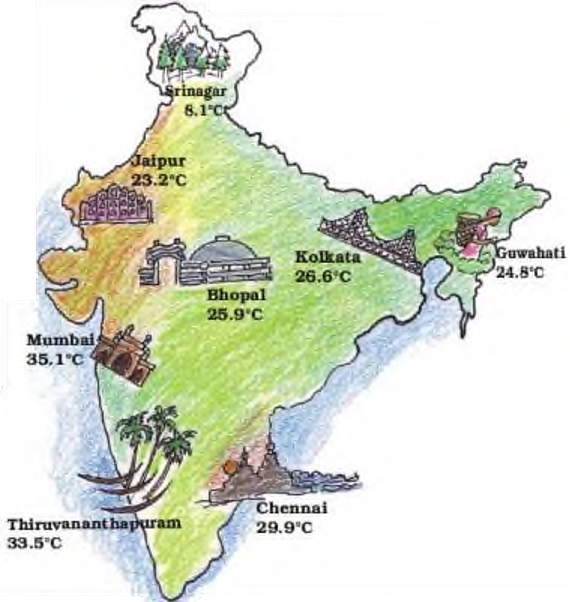
(1) Which place had the highest temperature at 3 pm? Which place is the coolest at that time?
(2) How much higher is the temperature in Mumbai from that in Srinagar?
(3) How many degrees will the temperature need to rise for it to reach 40°C in Thiruvananthapuram?
(4) How much lower is the temperature of Kolkata from that in Chennai?
(5) The temperature in these cities was also noted at 3 am on the same day. Look at the table and answer the questions.
(a) Which place had the lowest temperature at 3 am? Imagine yourself to be there and describe how it would feel.
(b) What is the difference between the temperatures at 3 pm and 3 am in Chennai? In Bhopal?
|
City |
Temperature at 3 am |
|
Chennai |
21.1 |
|
Mumbai |
19.0 |
|
Th’puram |
21.6 |
|
Kolkata |
13.1 |
|
Bhopal |
9.8 |
|
Srinagar |
1.3 |
|
Guwahati |
12.8 |
|
Jaipur |
10.2 |
Answer:
(1) Mumbai had the highest temperature i.e. 35.1°C at 3 pm. Srinagar was the coolest place with the temperature of 8.1°C at 3 pm.
(2) Temperature of Mumbai at 3 pm = 35.1∘C Temperature of Srinagar at 3 pm = 8.1∘C Difference in temperature = 35.1∘C − 8.1∘C = 27∘C
(3) Temperature of Thiruvananthapuram at 3 pm = 33.5∘C Rise in the temperature needed to attain a temperature of 40∘C = 40∘C − 33.5∘C = 6.5∘C
(4) Temperature of Chennai at 3 pm = 29.9∘C Temperature of Kolkata at 3 pm = 26.6∘C Difference between temperature = 29.9∘C − 26.6∘C = 3.3∘C
(5)
(a) Temperature of Srinagar at 3 am = 1.3∘C It will be very cold there.
(b) Temperature of Chennai at 3 pm = 29.9∘C Temperature of Chennai at 3 am = 21.1∘C Difference between temperature = 29.9∘C − 21.1∘C = 8.8∘C
Temperature of Bhopal at 3 pm = 25.9∘C Temperature of Bhopal at 3 am
= 9.8∘C Difference between temperature = 25.9∘C − 9.8∘C =16.1∘C